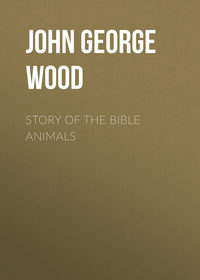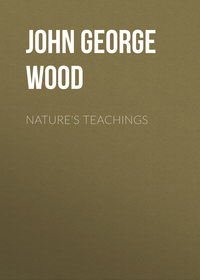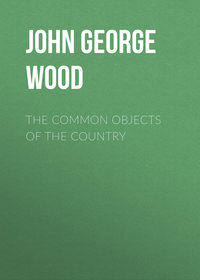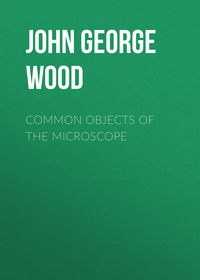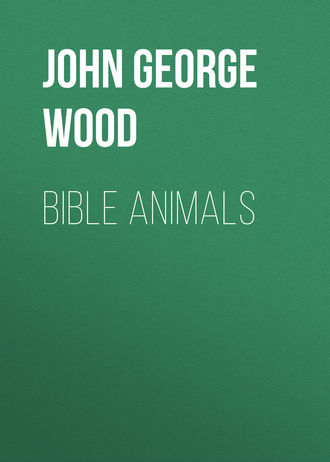 полная версия
полная версияBible Animals
When stacked or laid up in barns, the harvest is by no means safe, for the Mice will penetrate into any ordinary barn, and find their way into any carelessly-built stack, from which they can scarcely be ejected. The rat itself is not so dire a foe to the farmer, as the less obtrusive, but equally mischievous Field-mouse. The ferret will drive the rats out of their holes, and if they have taken possession of a wheat-stack they can be ejected by depriving them of access to water. But the burrows of the Field-mouse are so small that a ferret cannot make its way through them, and the nightly dew that falls on the stack affords an ample supply of water.
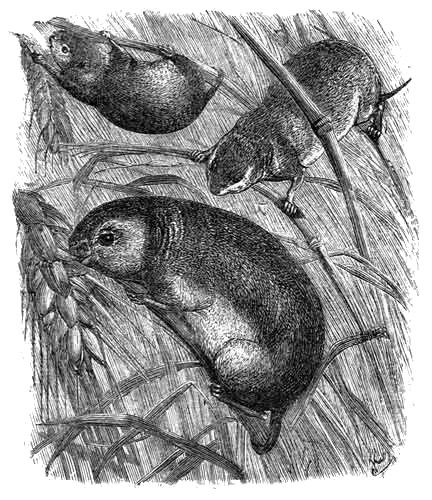
THE FIELD-MOUSE.
"Wherefore ye shall make images of your mice that mar the land."—1 Sam. vi. 5.
When the Field-mouse is deprived of the food which it loves best, it finds a subsistence among the trees. Whenever mice can discover a newly-planted sapling, they hold great revel upon it, eating away the tender young bark as high as they can reach, and consequently destroying the tree as effectually as if it were cut down. Even when the young trees fail them, and no tender bark is to be had, the Field-mice can still exert their destructive powers. They will then betake themselves to the earth, burrow beneath its surface, and devour the young rootlets of the forest trees. All botanists know that a healthy tree is continually pushing forward fresh roots below the ground, in order to gain sufficient nourishment to supply the increasing growth above. If, therefore, these young roots are destroyed, the least harm that can happen to the tree is that its further growth is arrested; while, in many cases, the tree, which cannot repair the injuries it has received, droops gradually, and finally dies. Even in this country, the Field-mouse has proved itself a terrible enemy to the agriculturist, and has devastated considerable tracts of land.
So much for the destructive powers of the Field-mouse, and the next point to be considered is its abundance.
Nearly all the rats and mice are singularly prolific animals, producing a considerable number at a brood, and having several broods in a season. The Field-mouse is by no means an exception to the general rule, but produces as many young in a season as any of the Mice.
Not only is it formidable from its numbers, but from the insidious nature of its attacks. Any one can see a rabbit, a hare, or even a rat; but to see a Field-mouse is not easy, even when the little creatures are present in thousands. A Field-mouse never shows itself except from necessity, its instinct teaching it to escape the observation of its many furred and feathered enemies. Short-legged and soft-furred, it threads its noiseless way among the herbage with such gentle suppleness that scarcely a grass-blade is stirred, while, if it should be forced to pass over a spot of bare ground, the red-brown hue of its fur prevents it from being detected by an inexperienced eye. Generally the Field-mouse is safe from human foes, and has only to dread the piercing eye and swift wings of the hawk, or the silent flight and sharp talons of the owl.
Although there can be no doubt that the Field-mouse is one of the animals to which the name of Akbar is given, it is probable that many species were grouped under this one name. Small rodents of various kinds are very plentiful in Palestine, and there are several species closely allied to the Field-mouse itself.
Among them is the Hamster (Cricetus frumentarius), so widely known for the ravages which it makes among the crops. This terribly destructive animal not only steals the crops for immediate subsistence, but lays up a large stock of provisions for the winter, seeming to be actuated by a sort of miserly passion for collecting and storing away. There seems to be no bounds to the quantity of food which a Hamster will carry into its subterranean store-house, from seventy to one hundred pounds' weight being sometimes taken out of the burrow of a single animal. The fact of the existence of these large stores shows that the animal must need them, and accordingly we find that the Hamster is only a partial hibernator, as it is awake during a considerable portion of the winter months, and is consequently obliged to live on the stores which it has collected.
It is an exceedingly prolific animal, each pair producing on an average twenty-five young in the course of a year. The families are unsociable, and, as soon as they are strong enough to feed themselves, the young Hamsters leave their home, and make separate burrows for themselves. Thus we see that the Hamster, as well as the Field-mouse, fulfils the conditions which are needed in order to class it under the general title of Akbar.
I have already stated that some translators of the Bible use the word Jerboa as a rendering of the Hebrew Akbar. As the Jerboa certainly is found in Palestine, there is some foundation for this idea, and we may safely conjecture that it also is one of the smaller rodents which are grouped together under the appellation of Mouse.
The Common Jerboa (Dipus Ægyptiacus) is plentiful in Palestine, and several other species inhabit the same country, known at once by their long and slender legs, which give them so curious a resemblance to the kangaroos of Australia. The Jerboas pass over the ground with astonishing rapidity. Instead of creeping stealthily among the grass-blades, like the short-limbed field-mouse, the Jerboa flies along with a succession of wonderful leaps, darting here and there with such rapidity that the eye can scarcely follow its wayward movements. When quiet and undisturbed, it hops along gently enough, but as soon as it takes alarm, it darts off in its peculiar manner, which is to the ordinary walk of quadrupeds what the devious course of a frightened snipe is to the steady flight of birds in general.
It prefers hot and dry situations, its feet being defended by a thick coating of stiff hairs, which serve the double purpose of protecting it from the heat, and giving it a firm hold on the ground. It is rather a destructive animal, its sharp and powerful teeth enabling it to bite its way through obstacles which would effectually stop an ordinary Mouse. That the Jerboa may be one of the Akbarim is rendered likely by the prohibition in Lev. xi. 29, forbidding the Mouse to be eaten. It would be scarcely probable that such a command need have been issued against eating the common Mouse, whereas the Jerboa, a much larger and palatable animal, is always eaten by the Arabs. The Hamster is at the present day eaten in Northern Syria.
Beside these creatures there are the Dormice, several species of which animal inhabit Palestine at the present day. There are also the Sand-rats, one species of which is larger than our ordinary rats. The Sand-rats live more in the deserts than the cultivated lands, making their burrows at the foot of hills, and among the roots of bushes.
THE HARE
The prohibitions of the Mosaic law—The chewing of the cud, and division of the hoof—Identity of the Hare of Scripture—Rumination described—The Hare a rodent and not a ruminant—Cowper and his Hares—Structure of the rodent tooth—The Mosaic law accommodated to its recipients—The Hares of Palestine and their habits.
Among the many provisions of the Mosaic law are several which refer to the diet of the Israelites, and which prohibit certain kinds of food. Special stress is laid upon the flesh of animals, and the list of those which may be lawfully eaten is a singularly restricted one, all being excluded except those which "divide the hoof and chew the cud." And, lest there should be any mistake about the matter, examples are given both of those animals which may and those which may not be eaten.
The ox, sheep, goat, and antelopes generally are permitted as lawful food, because they fulfil both conditions; whereas there is a special prohibition of the swine, because it divides the hoof but does not chew the cud, and of the camel, coney, and hare because they chew the cud, but do not divide the hoof. Our business at present is with the last of these animals.
Considerable discussion has been raised concerning this animal, because, as is well known to naturalists, the Hare is not one of the ruminant animals, but belongs to the same order as the rat, rabbit, beaver, and other rodents. Neither its teeth nor its stomach are constructed for the purpose of enabling it to ruminate, i.e. to return into the mouth the partially-digested food, and then to masticate it afresh; and therefore it has been thought that either there is some mistake in the sacred narrative, or that the Hebrew word has been mistranslated.
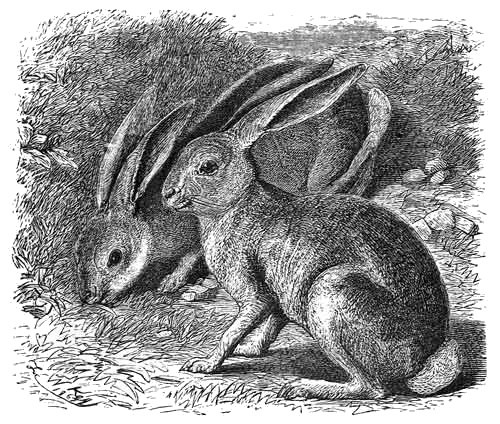
THE SYRIAN HARE.
"Nevertheless, these ye shall not eat of them that chew the cud, or of them that divide the cloven hoof: as the camel, and the hare, and the coney."—Deut. xiv. 7.
Taking the latter point first, as being the simplest of the two, we find that the Hebrew word which is rendered as Hare is Arnebeth, and that it is rendered in the Septuagint as Dasypus, or the Hare,—a rendering which the Jewish Bible adopts. That the Arnebeth is really the Hare may also be conjectured from the fact that the Arabic name for that animal is Arneb. In consequence of the rather wide sense to which the Greek word Dasypus (i.e. hairy-foot) is used, some commentators have suggested that the rabbit may have been included in the same title. This, however, is not at all likely, inasmuch as the Hare is very plentiful in Palestine, and the rabbit is believed not to be indigenous to that part of the world. And, even if the two animals had been classed under the same title, the physiological difficulty would not be removed.
Before proceeding further, it will be as well to give a brief description of the curious act called rumination, or "chewing the cud."
There are certain animals, such as the oxen, antelopes, deer, sheep, goats, camels, &c. which have teeth unfitted for the rapid mastication of food, and which therefore are supplied with a remarkable apparatus by which the food can be returned into the mouth when the animal has leisure, and be re-masticated before it passes into the true digestive organs.
For this purpose they are furnished with four stomachs, which are arranged in the following order. First comes the paunch or "rumen" (whence the word "ruminating"), into which passes the food in a very rough state, just as it is torn, rather than bitten, from the herbage, and which is analogous to the crop in birds. It thence passes into the second stomach, or "honeycomb," the walls of which are covered with small angular cells. Into those cells the food is received from the first stomach, and compressed into little balls, which can be voluntarily returned into the mouth for mastication.
After the second mastication has been completed, the food passes at once into the third stomach, and thence into the fourth, which is the true digesting cavity. By a peculiar structure of these organs, the animal is able to convey its food either into the first or third stomach, at will, i.e. into the first when the grass is eaten, and into the third after rumination. Thus it will be seen that an animal which chews the cud must have teeth of a certain character, and be possessed of the fourfold stomach which has just been described.
Two points are conceded which seem to be utterly irreconcilable with each other. The first is that the Mosaic law distinctly states that the Hare chews the cud; the second is, that in point of fact the Hare is not, and cannot be, a ruminating animal, possessing neither the teeth nor the digestive organs which are indispensable for that process. Yet, totally opposed as these statements appear to be, they are in fact, not so irreconcilable as they seem.
Why the flesh of certain animals was prohibited, we do not at the present time know. That the flesh of swine should be forbidden food is likely enough, considering the effects which the habitual eating of swine's flesh is said to produce in hot countries. But it does seem very strange that the Israelites should have been forbidden to eat the flesh of the camel, the coney (or hyrax), and the Hare, and that these animals should have been specified is a proof that the eating or refraining from their flesh was not a mere sanitary regulation, but was a matter of importance. The flesh of all these three animals is quite as good and nutritious as that of the oxen, or goats, which are eaten in Palestine, and that of the Hare is far superior to them. Therefore, the people of Israel, who were always apt to take liberties with the restrictive laws, and were crafty enough to evade them on so many occasions, would have been likely to pronounce that the flesh of the Hare was lawful meat, because the animal chewed the cud, or appeared to do so, and they would discreetly have omitted the passage which alluded to the division of the hoof.
To a non-scientific observer the Hare really does appear to chew the cud. When it is reposing at its ease, it continually moves its jaws about as if eating something, an action which may readily be mistaken for true rumination. Even Cowper, the poet, who kept some hares for several years, and had them always before his eyes, was deceived by this mumbling movement of the jaws. Speaking of his favourite hare, "Puss," he proceeds as follows: "Finding him exceedingly tractable, I made it my custom to carry him always after breakfast into the garden, where he hid himself generally under the leaves of a cucumber vine, sleeping, or chewing the cud, till evening."
The real object of this continual grinding or mumbling movement is simple enough. The chisel-like incisor teeth of the rodent animals need to be rubbed against each other, in order to preserve their edge and shape, and if perchance such friction should be wanting to a tooth, as, for example, by the breaking of the opposite tooth, it becomes greatly elongated, and sometimes grows to such a length as to prevent the animal from eating. Instinctively, therefore, the Hare, as well as the rabbit and other rodents, always likes to be nibbling at something, as any one knows who has kept rabbits in wooden hutches, the object of this nibbling not being to eat the wood, but to keep the teeth in order.
But we may naturally ask ourselves, why the Mosaic law, an emanation from heaven, should mention an animal as being a ruminant, when its very structure shows that such an act was utterly impossible? The answer is clear enough. The law was suited to the capacity of those for whom it was intended, and was never meant to be a handbook of science, as well as a code of religious duties and maxims. The Jews, like other Orientals, were indifferent to that branch of knowledge which we designate by the name of physical science, and it was necessary that the language in which the law was conveyed to them should be accommodated to their capabilities of receiving it.
It would have been worse than useless to have interrupted the solemn revelation of Divine will with a lesson in comparative anatomy; the object of the passage in question being, not to teach the Jews the distinctive characteristics of a rodent and a ruminant, but to guard against their mistaking the Hare for one of the ruminants which were permitted as food. That they would in all probability have fallen into that mistake is evident from the fact that the Arabs are exceedingly fond of the flesh of the Hare, and accept it, as well as the camel, as lawful food, because it chews the cud, the division of the hoof not being considered by them as an essential.
Hares are very plentiful in Palestine, and at least two species are found in that country. One of them, which inhabits the more northern and hilly portion of Palestine, closely resembles our own species, but has not ears quite so long in proportion, while the head is broader. The second species, which lives in the south, and in the valley of the Jordan, is very small, is of a light dun colour, and has very long ears. In their general habits, these Hares resemble the Hare of England.
CATTLE
The cattle of Palestine, and their decadence at the present day—Ox-flesh not used for food in modern times—Oxen of the stall, and oxen of the pasture—The use of the ox in agriculture—The yoke and its structure—The plough and the goad—The latter capable of being used as a weapon—Treading out the corn—The cart and its wheels—The ox used as a beast of burden—Cattle turned loose to graze—The bulls of Bashan—Curiosity of the ox-tribe—A season of drought—Branding the cattle—An Egyptian field scene—Cattle-keeping an honourable post—The ox as used for sacrifice—Ox-worship—The bull Apis, and his history—Persistency of the bull-worship—Jeroboam's sin—Various names of cattle—The Indian buffalo.
Under this head we shall treat of the domesticated oxen of Scripture, whether mentioned as Bull, Cow, Ox, Calf, Heifer, &c.
Two distinct species of cattle are found in Palestine, namely, the ordinary domesticated ox, and the Indian buffalo, which lives in the low-lying and marshy valley of the Jordan. Of this species we shall treat presently.
The domesticated cattle are very much like our own, but there is not among them that diversity of breed for which this country is famous; nor is there even any distinction of long and short horned cattle. There are some places where the animals are larger than in others, but this difference is occasioned simply by the better quality and greater quantity of the food.
As is the case in most parts of the world where civilization has made any progress, Domesticated Cattle were, and still are, plentiful in Palestine. Even at the present time the cattle are in common use, though it is evident, from many passages of Holy Writ, that in the days of Judæa's prosperity cattle were far more numerous than they are now, and were treated in a better fashion.
To take their most sacred use first, a constant supply of cattle was needed for the sacrifices, and, as it was necessary that every animal which was brought to the altar should be absolutely perfect, it is evident that great care was required in order that the breed should not deteriorate, a skill which has long been rendered useless by the abandonment of the sacrifices.
Another reason for their better nurture in the times of old is that in those days the ox was largely fed and fatted for the table, just as is done with ourselves. At the present day, the flesh of the cattle is practically unused as food, that of the sheep or goat being always employed, even when a man gives a feast to his friends. But, in the old times, stalled oxen, i.e. oxen kept asunder from those which were used for agricultural purposes, and expressly fatted for the table, were in constant use. See for example the well-known passage in the Prov. xv. 17, "Better is a dinner of herbs where love is, than a stalled ox and hatred therewith." Again, the Prophet Jeremiah makes use of a curious simile, "Egypt is like a very fair heifer, but destruction cometh; it cometh out of the north. Also her hired men are in the midst of her like fatted bullocks [or, bullocks of the stall], for they also are turned back, and are fled away together." (Jer. xlvi. 20.) And in 1 Kings iv. 22, 23, when describing the glories of Solomon's household, the sacred writer draws a distinction between the oxen which were especially fattened for the table of the king and the superior officers, and those which were consumed by the lower orders of his household: "And Solomon's provision for one day was thirty measures of fine flour, and threescore measures of meal, ten fat oxen, and twenty oxen out of the pastures, and an hundred sheep, beside harts, and roebucks, and fallow-deer, and fatted fowl." Again, in the well-known parable of the king's marriage, there is an allusion to fatted animals, and a distinction is made between the oxen of the pasture and those of the stall. "Again, he sent forth other servants, saying, Tell them which are bidden, Behold, I have prepared my dinner, my oxen and my fatlings are killed, and all things are ready."
Calves—mostly, if not always, bull-calves—were largely used for food in Palestine, and in the households of the wealthy were fatted for the table. See, for example, the familiar parable of the prodigal son, in which the rejoicing father is mentioned as preparing a great feast in honour of his son's return, and ordering the fatted calf to be killed—the calf in question being evidently one of the animals that were kept in good condition against any festive occasion. And, even in the earliest history of the Bible, the custom of keeping a fatted calf evidently prevailed, as is shown by the conduct of Abraham, who, when he was visited by the three heavenly guests, "ran unto the herd, and fetched a calf, tender and good," and had it killed and dressed at once, after the still existing fashion of the East.
But, even in the times of Israel's greatest prosperity, the chief use of the ox was as an agricultural labourer, thus reversing the custom of this country, where the horse has taken the place of the ox as a beast of draught, and where cattle are principally fed for food. Ploughing was, and is, always performed by oxen, and allusions to this office are scattered plentifully through the Old and New Testaments.
When understood in this sense, oxen are almost always spoken of in connexion with the word "yoke," and as each yoke comprised two oxen, it is evident that the word is used as we employ the term "brace," or pair. The yoke, which is the chief part of the harness, is a very simple affair. A tolerably stout beam of wood is cut of a sufficient length to rest upon the necks of the oxen standing side by side, and a couple of hollows are scooped out to receive the crest of the neck. In order to hold it in its place, two flexible sticks are bent under their necks, and the ends fixed into the beam of the yoke. In the middle of this yoke is fastened the pole of the plough or cart, and this is all the harness that is used, not even traces being required.
It will be seen that so rude an implement as this would be very likely to gall the necks of the animals, unless the hollows were carefully smoothed, and the heavy beam adapted to the necks of the animals. This galling nature of the yoke, so familiar to the Israelites, is used repeatedly as a metaphor in many passages of the Old and New Testaments. These passages are too numerous to be quoted, but I will give one or two of the most conspicuous among them. The earliest mention of the yoke in the Scriptures is a metaphor.
After Jacob had deceived his father, in procuring for himself the blessing which was intended for his elder brother, Isaac comforts Esau by the prophecy that, although he must serve his brother, yet "it shall come to pass when thou shalt have the dominion, that thou shalt break his yoke from off thy neck." Again, in the next passage where the yoke is mentioned, namely, Lev. xxvi. 13, the word is employed in the metaphorical sense: "I am the Lord your God, which brought you forth out of the land of Egypt, that ye should not be their bondmen, and I have broken the bands of your yoke, and made you go upright."
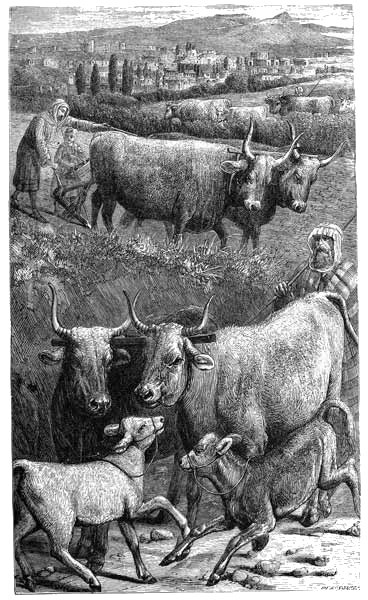
"It is good for a man to bear the yoke in his youth."—Lam. iii. 27.
"He maketh them also to skip like a calf."—Psalm 6.
Then, in Deut. xxviii. 48, the word yoke is not only used metaphorically, but with an addition that forcibly expresses its weight and galling character: "Therefore shalt thou serve thine enemies, which the Lord shall send against thee, in hunger, and in thirst, and in nakedness, and in want of all things, and He shall put a yoke of iron upon thy neck, until He have destroyed thee."
The word yoke is also used as a metaphor for servitude, even of a domestic character, as we may see in 1 Tim. vi. 1: "Let as many servants as are under the yoke count their own masters worthy of all honour." In the Acts of the Apostles, we find St. Peter using the same metaphor: "Why tempt ye God, to put a yoke on the neck of the disciples, which neither our fathers nor we were able to bear?" And the Lord Himself uses the same metaphor in the well-known passage, "Take my yoke upon you, for my yoke is easy and my burden light."




